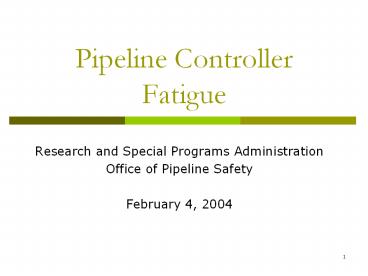Pipeline Controller Fatigue - PowerPoint PPT Presentation
1 / 21
Title:
Pipeline Controller Fatigue
Description:
... knowledge on fatigue, sleep, and circadian physiology to address work/rest ... sleep, irregular schedules, and work during low points in circadian rhythms ... – PowerPoint PPT presentation
Number of Views:307
Avg rating:3.0/5.0
Title: Pipeline Controller Fatigue
1
Pipeline Controller Fatigue
- Research and Special Programs Administration
- Office of Pipeline Safety
- February 4, 2004
2
Operational Definition
Fatigue is a complex state characterized by a
lack of alertness and reduced mental and physical
performance, often accompanied by drowsiness.
Fatigue is MORE THAN sleepiness and effects are
more than falling asleep.
3
The Fatigue Puzzle
Workload, Stress Monotony
Disrupted Work/Rest cycles
Ergonomic Design
Noise, Vibration Temperature
Aging, Health
Nutrition Conditioning
Sleep Loss
Medications, drugs Alcohol
4
NTSB Recommendation P-98-30
- Assess the potential safety risks associated
with rotating pipeline controller shifts and
establish industry guidelines for the development
and implementation of pipeline controller work
schedules that reduce the likelihood of accidents
attributable to controller fatigue - 1996 Fork Shoals, SC accident
5
NTSB Concerns
- Controller could have been suffering from fatigue
due to rotating shifts - May have affected alertness and responsiveness
during accident sequence - Need for assessment and incorporation of
knowledge on fatigue, sleep, and circadian
physiology to address work/rest schedules and
rotating shifts
6
NTSB Safety Recommendation P-99-12
- Establish within two years scientifically based
hours-of-service regulations that set limits on
hours of service, provide predictable work and
rest schedules, and consider circadian rhythms
and human sleep and rest requirements - 1999 NTSB Special Report on Operator Fatigue
7
NTSB Concerns
- Scientific research has shown that alertness of
controllers can be impacted by insufficient
sleep, irregular schedules, and work during low
points in circadian rhythms - Current shift schedules do not often incorporate
fatigue control measures
8
DOT under Pressure to Improve Transportation
Safety
Commercial
Management
NTSB
Congress
Public
Labor
Academia
Administration
9
Hours of Service regulations
- Aviation 8 in 24 12 in 24 80/mo
- Railroad 8 off after working 1159 10 off after
12 - Trucking 11 driving, 10 off
- Marine not required to work more than 8/day
often work 14/day, 7 days/wk - Pipelines none
- Hours of Service regulations have not been shown
to solve fatigue problems
10
Fatigue in Controller Schedules
- Pipeline controllers work in environments
requiring - the extension of work hours beyond 8 hours per
day - mental and physical stress
- varying high and low workloads
- shift rotations from daytime to nighttime
schedules - irregular work/rest patterns
11
DOT Responds to NTSB
- Understand work and rest schedules
- Examine changing Hours of Service rules
- Develop fatigue management training
- Evaluate fatigue monitoring technologies
- Understand the effects of work schedule
- on performance and fatigue
- Validate fatigue management tools
12
New Perspective
- Human Factors Coordinating Committee (HFCC)
Sponsors Partnering in Transportation Safety
meeting in August, 2000 - HFCC sponsors a Broad Agency Announcement
procurement of four fatigue management tools - http//scitech.dot.gov/research/human/
13
DOT Operator Fatigue Management Initiative
- Government typically finds itself caught between
management and labor with regard to hours of
service issues - The HFCC is developing tools for use by labor and
industry to reduce the number of accidents
related to operator fatigue - Tool development focuses on non-prescriptive
approach to fatigue management its utility - The products are intended for direct application
by industry and labor
14
Current and Future Products
- Software to allow comparison of schedules
- Compendium of fatigue and countermeasure-related
information - Strategic planning tool for DOT use
- Methodology to validate fatigue models
- Business case tools
- Create facility for sharing and collecting
information - Education for managers
15
DOT Fatigue Management
- Schedule analysis tool intended for use by
- schedulers
- accident investigators
- workers
- Software tool (XIMES)
- incorporates
- comprehensive review of fatigue-sensitive work
schedule information - approach for evaluating work schedules against
best practice guidelines to maximize on-duty
alertness. - Software free to US transportation organizations
- Flexible to be relevant to the various modes
16
Fatigue Management Reference (FMR)
- Handbook of best practices for fatigue
management - provides guidance for managers to identify,
implement, and evaluate fatigue management
approaches - Includes state-of-the-art understanding of
fatigue and fatigue management - Living, multimodal document
17
FMR Table of Contents
- Operational Fatigue Risk Factors
- Schedule characteristics, sleep disruption diet,
work stress - Fatigue Management Program Concepts
- Organizational commitment, partnerships, health
screening - Review of Fatigue Countermeasures
- Segregated by those that work, under development,
require supervision, and those that do not work - Sleep Basics
18
DOT Fatigue Management Fatigue Resource Directory
- FReDi
- Provide transportation-industry with current,
accessible information on resources available to
address fatigue in transportation.
19
OPS Pipeline Controller Fatigue Study
- OPS has an ongoing agreement with the Volpe
National Transportation Systems Center to study
pipeline controller fatigue. - Volpe wants to take advantage of the progress
made by the HFCC in developing fatigue management
tools. - Proposed new direction includes the development
of an industry working group and several industry
partners willing to allow the demonstration and
evaluation of the new DOT fatigue management
tools.
20
Applying the Tools
- Two of the tools, the XIMES Work Schedule
Representation and Analysis Software and the
Fatigue Management Reference, are now ready for
use by the pipeline industry. - The proposed Phase I encompasses testing these
new tools for pipeline controller scheduling. - A more substantial Phase II can be considered, in
which the impact of the entire fatigue management
program is evaluated in terms of increases in
safety and productivity.
21
END

